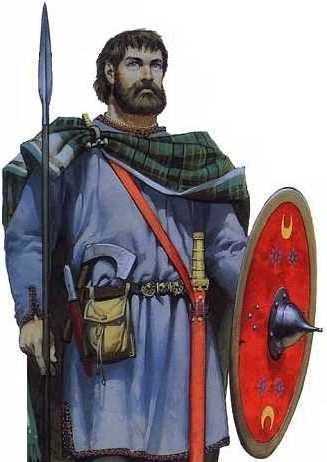I guess this topic goes here…?
I’ve been playing around with this wool cloak I got for my “Barbarians” themed birthday party last year. I researched what the classic Germanic Tribesman would have worn during the Roman Empire era (2000 years ago). I modeled it after this picture:

From this website: http://www.geocities.ws/reginheim/everydaylife.html
Here was my version:
While camping this summer I thought about wearing my buckskins, but they are so heavy and clammy (I need to wash and buff them up) and heavy. I wanted something warm and light, so I thought it would be fun to try out this piece of cloth on the trip. It worked so well! I love it. Just a punch of woolen plaid cloth folded up and pinned together. It’s still very “iron age” and probably more sedintary in nature, as it would require pastoralism and looms, but I think it’s a step in the direction I am heading. Wool is warm when wet, silent, fire-resistant, not very processed, and much more. The plaid acts as a camouflage, breaking up the outline of the body. It’s not wonder this was a popular clothing item for so long.
So I got to thinking about Tartans, or specific colors and their attributions to “clans”. I started to wonder if there were German Tartans. I did a little searching and I saw this:
From: http://en.wikipedia.org/wiki/Tartan
Until the middle of the nineteenth century, the highland tartans were only associated with either regions or districts, rather than any specific clan. This was because like other materials tartan designs were produced by local weavers for local tastes and would usually only use the natural dyes available in that area, as chemical dye production was non-existent and transportation of other dye materials across long distances was prohibitively expensive.The patterns were simply different regional checked-cloth patterns, chosen by the wearer’s preference – in the same way as people nowadays choose what colours and patterns they like in their clothing, without particular reference to propriety. It was not until the mid-nineteenth century that many patterns were created and artificially associated with Scottish clans, families, or institutions who were (or wished to be seen as) associated in some way with a Scottish heritage.[1] The Victorians’ penchant for ordered taxonomy and the new chemical dyes then available meant that the idea of specific patterns of bright colours, or ‘dress’ tartans could be created and applied to a faux-nostalgic view of Scottish history.
This makes me a little sad, but also kind of stoked. To think that the idea of Tartans as a sort of family Uniform or national identity just makes me think about how much Empire homogenizes everyone, and that all culture is super fluid and even on individuals. It makes me think about the natural dyes that are here where I live, and how those colors could shape our own personal tastes, yet unite us not in the same patterns, but in the natural colors we choose. What a way to connect people to a landbase. It seems so Sherlock Holmes. Being able to identify a person’s region based not on the designs of their clothes, but by the colors they had available.
I’m also fairly relieved I don’t have to find the “right” tartan for my region, but look into the plants that are growing in the regions of Germania where my origins lie and then maybe seek out similar plants here in the PNW. What a cool way to become interested in the plants of Europe.

